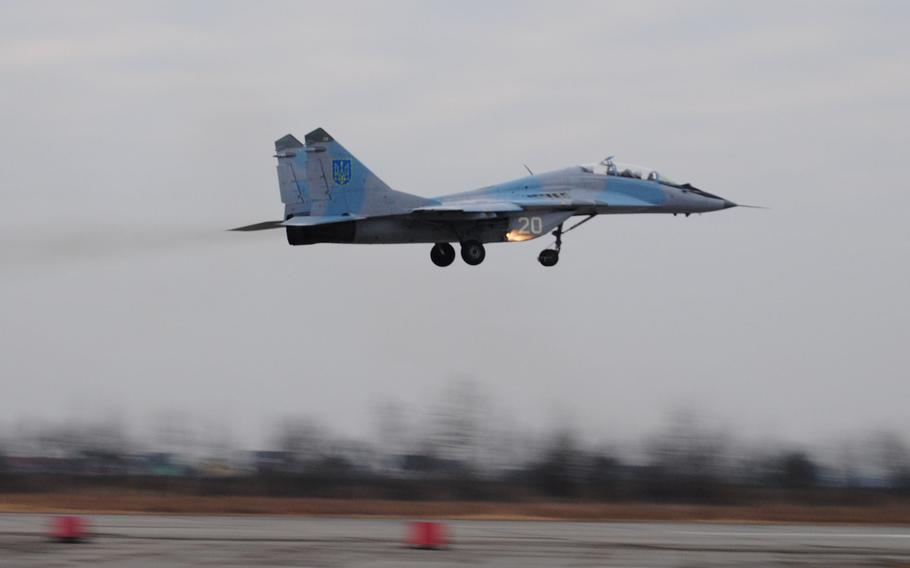The "Ghost of Kyiv."
That's what admirers called a Ukrainian fighter pilot who was said to have shot down 40 enemy planes. Over the weekend, Ukrainian officials admitted that the ghost, in fact, never existed.
"Ghost of Kyiv is a superhero-legend whose character was created by Ukrainians," Ukraine's air force said Saturday, confirming that it was all a bit of mythmaking.
The news came two days after the Times of London identified the ghost as Maj. Stepan Tarabalka, a pilot who died March 13 in an air battle with Russian forces.
The Ghost of Kyiv is one of the most successful pieces of propaganda promoting the prowess of the nation's fighting forces and lifting morale. Although Ukrainian officials and former president Petro Poroshenko promoted the myth, the air force warned people to not "neglect the basic rules of information hygiene" and to "check the sources of information, before spreading it."
Ukraine and Russia have been spreading propaganda during the war, with Ukraine focusing on hearts and minds internally and throughout the West. Government officials in the invaded country share day-to-day events, operations and victories on Twitter, Telegram and Facebook. Social media platforms have been struggling to keep up with fast-spreading, dubious information, engaging in fact-checking that sometimes goes beyond their own policies or contradicts them, The Washington Post has reported.
As Russia's invasion of Ukraine nears 2 1/2 months of bloodshed, the nations' fabricated messages don't have the same weight, propaganda scholars told The Post.
The Ukrainian air force said on Instagram that images of the ghost on social media are "a collective image of the pilots of the 40th Tactical Aviation Brigade of Air Force, which protects the sky of the capital," and that "they suddenly appear where they are not expected."
That didn't stop the myth from being promoted and capitalized upon.
Ukrainian model manufacturer ICM Plastic Model Kits used the ghost to promote its products and warned Russians against commenting on its post about the ace pilot shooting down 30 "planes of the invaders."
Days into the war, the Security Service of Ukraine claimed that the ghost had shot down 10 enemy planes, protecting Ukrainians. Facebook has since flagged the post as false.
With the aviation mystery now debunked, it's unclear why Ukrainian leaders decided to confess that the beloved pilot was falsely promoted as a real person.
Adam G. Klein, associate professor of communication studies at Pace University's New York City campus, said it's important to realize that Ukrainian soldiers and citizens are fighting a Russian military eight times larger.
"Perhaps [Ukrainian leaders] wanted to acknowledge the identity and bravery of the actual fighter pilot who was believed to be the Ghost of Kyiv and was recently killed in battle," he said, addressing the reason behind the reveal. "Perhaps the legend they created was no longer needed. But I suspect that at some point it becomes more valuable to remind these Ukrainian fighters that this feat is not the work of myth or superheroes, but rather the reality of actual Ukrainian fighters who have defended their skies together."
It's also possible that officials might have received criticism for continuing the charade and wanted to make things clear, said Samuel C. Woolley, assistant professor at the University of Texas at Austin's school of journalism and school of information. And, he said, the use of propaganda isn't always as sinister as the emotions the word evokes.
Woolley noted that the word "propaganda" has been stretched to be nearly unrecognizable from when the Catholic Church used the method to spread the religion in the New World, to a more modern-day use that includes denunciation of political opponents.
"The technical meaning is politically biased information that's spread with intent to influence public opinion or societal action," he said. "Propaganda is neither a good or bad thing. Yes, it's used for control, but the question is: Are Ukrainians using it in this circumstance to bring the country together as it's being attacked by an authoritarian regime?"
The Ghost of Kyiv probably was an encouraging figure akin to Rosie the Riveter of World War II or Uncle Sam, Woolley said, characters created to sway the public to support war and to summon feelings of patriotism.
"The comparison is an attempt to boost morale among countries fighting a despotic leader versus, on the Russian side, a despot attempting to use it to control media and to instill fear in his own populace to get done the things he needs to get done," he said.

Fighters of the Armed Forces of Ukraine are shown in a March 2011 photo. The “Ghost of Kyiv” is a superhero-legend whose character was created by Ukrainians,” Ukraine’s air force said Saturday, confirming that it was all a bit of mythmaking. (Taras Gren/Ministry of Defense of Ukraine)